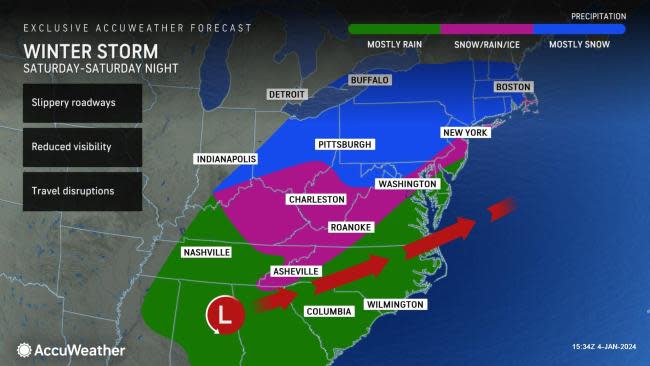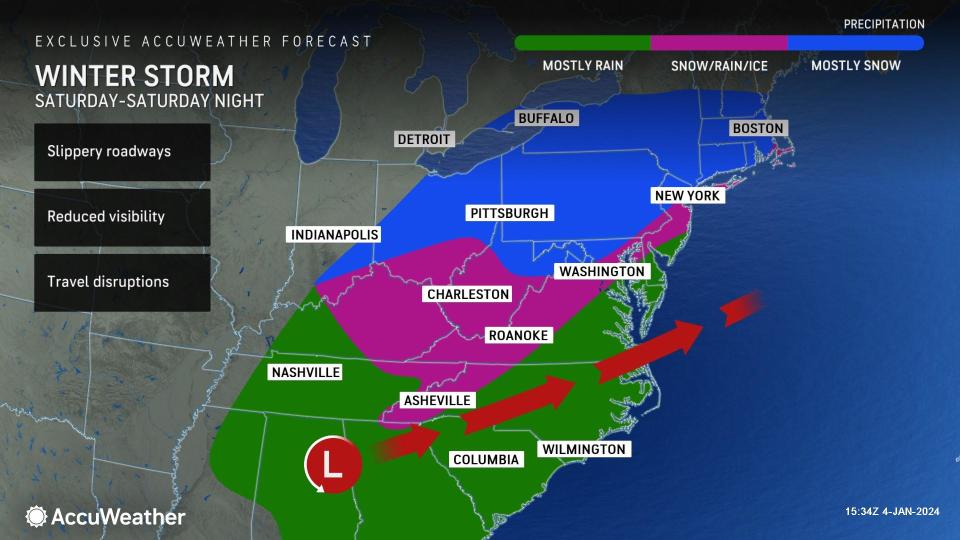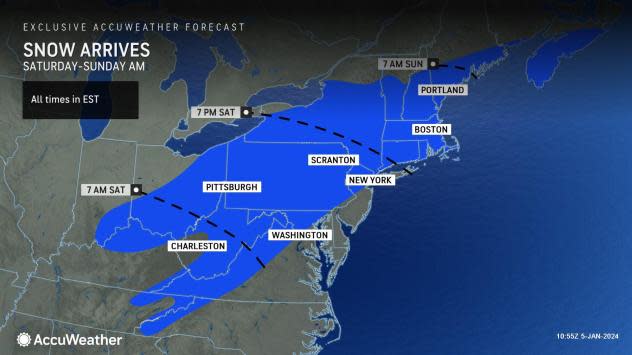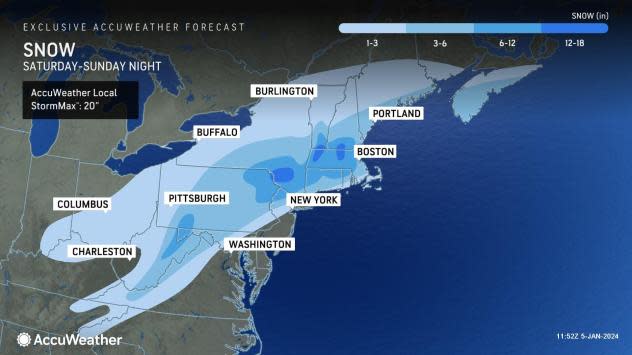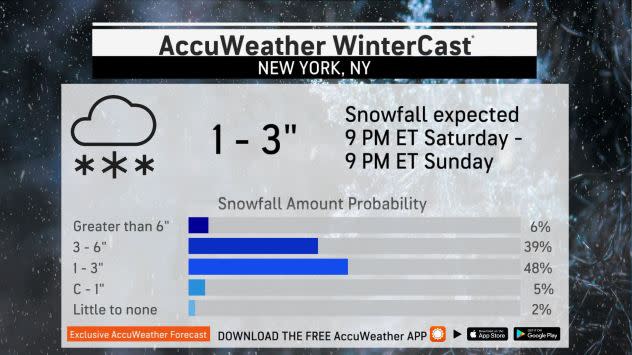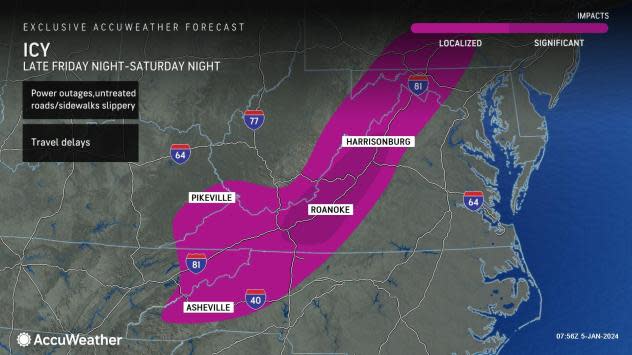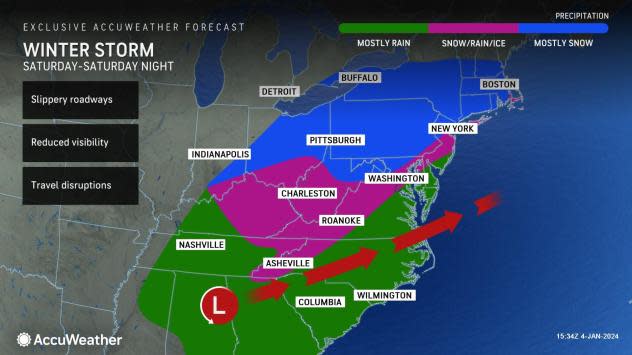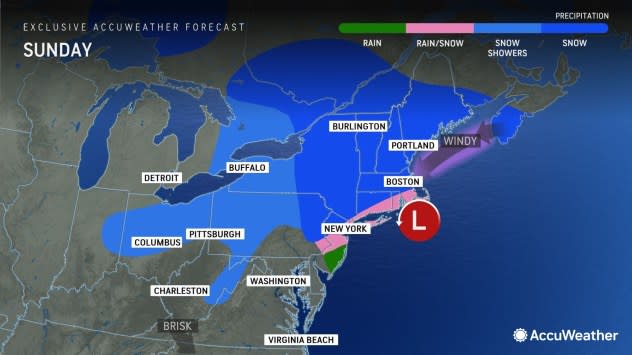Nor'easter to dump first significant snow in two years across East
A major winter storm packing travel-snarling snow and dangerous ice is on track to arrive in the Northeast this weekend, a storm that AccuWeather meteorologists say will deliver the first big snowfall along part of the Interstate 95 corridor in nearly two years.
The cross-country storm will first push across the Southwest into Thursday before swinging eastward, where it will deliver heavy rain and thunderstorms to the Gulf Coast states before evolving into the year's first major snowstorm along the upper portion of the East Coast.
From late Thursday night to Friday night, a swath of drenching rainfall and locally gusty thunderstorms will begin to impact areas of the Gulf Coast. The persistent rainfall could bring drought relief for some, especially for parts of Louisiana and Mississippi, where levels of extreme to exceptional drought have gripped the region, according to the U.S. Drought Monitor.
As the storm advances northeastward to the mid-Atlantic coast from Saturday into Sunday, it is expected to strengthen as it dumps snow and ice in a zone spanning from the central Appalachians to New England. Forecasters caution that the heaviest snow is taking aim from northeastern Pennsylvania to central and southern New England, where nearly a foot of snow may pile up.
 |
Travel conditions can rapidly deteriorate throughout Saturday and Saturday night as snow and ice spread across the region. From Saturday to Sunday, a swath where enough snow to shovel and plow is projected to fall from the Smoky Mountains to part of northern New England.
Heavy snowfall totals between 6 to 12 inches can be collected from the higher terrain in northern West Virginia, western Maryland and southwestern Pennsylvania. But as the storm gains strength and moisture from the Atlantic, it will begin to unload snow at a heavy and steady rate from northeastern Pennsylvania to the middle and lower part of the Hudson Valley to central and southern New England. 6-12 inches of snow will be common in this area, with the AccuWeather Local StormMax™ of 20 inches.
Hourly snowfall rates in this zone may exceed an inch per hour, which can overwhelm city and highway departments. Motorists on the roads during the height of the storm may be at risk for becoming stuck or stranded.
 |
Motorists are urged to check their local forecast and stay aware of changing weather conditions before taking to the roads, especially any college students returning to campus since winter break comes to an end this week for some universities.
After a relatively mild December for parts of the Northeast, this weekend's storm may be a sharp snap back to reality for some, as the heart of winter is quickly approaching. This weekend, millions across the Northeast may experience their first winter storm featuring snowfall amounts greater than 1 inch since early 2022.
"Any accumulating snow can result in significant travel slowdowns, but this storm may have a greater impact than others of similar magnitude because it has been such a long time since more than 1 inch of snow has accumulated in these areas - it can take people a bit of time to once again get used to driving in and otherwise dealing with the snow," explained AccuWeather Chief Meteorologist Jon Porter. "This is typically experienced during the first snowstorm of a season, like this one, but is amplified since it's the first storm in several years,"
A few inches of snow or more can occur along the I-95 corridor from New York City to Boston, which would be the most snow some of these cities have seen since early 2022 thanks to the multiyear drought of major snowstorms in these areas, added Porter.
 |
The last time a single storm delivered more than an inch of snow in New York City was on Feb. 13, 2022. Warm air from the ocean will likely play a role in New York City, with a mixing or change to rain likely at the storm's height.
The last time there was a snowstorm that brought at least an inch of snow to Philadelphia was on Jan. 28-29, 2022. However, this may not be the storm to snap the string in Philadelphia, Baltimore and Washington, D.C., along I-95. The storm may still be struggling in strength as it passes through these areas and, combined with the warming effects of the Atlantic, could result in much more rain rather than accumulating snow.
Snowfall accumulations will ramp up as they often do north and west of I-95 in the mid-Atlantic, with a few inches for some of the northern and western suburbs. However, not too far to the north and west of New York City, the snowfall may ramp up exponentially from the strengthening storm.
Of all the major cities along I-95, Boston is in the best position to pick up 4-8 inches of snow from the storm with even heavier amounts to the west of the city, where any mixing in of sleet and rain is unlikely.
As cold air is pulled southward, a mixture of snow, sleet and freezing rain can spread over parts of far eastern Tennessee and western North Carolina through eastern West Virginia and western Virginia, but the ice threat is mainly expected to be elevational dependent. Locations surrounding the Smoky Mountains to the Blue Ridge Mountains could face the greatest risk for dangerous ice buildup.
 |
While some elevations could receive a mixture of snow and sleet, leaving untreated sidewalks and roadways slippery, others could have mainly freezing rain. The accumulation of ice poses additional risks, including the potential for tree branches to snap and weigh down power lines, leading to power outages.
"Travelers are urged to exercise extreme caution as seemingly wet roads may be coated with a hazardous layer of ice," noted AccuWeather Meteorologist Elizabeth Danco.
Being prepared with extra batteries, fully-charged cell phones and a generator, if available, will come in handy in the case of localized or widespread power outages.
 |
Residents across portions of the Tennessee and Ohio valleys through New England will want to dust off their snow shovels and snow blowers and ensure their vehicle tires have a healthy amount of tread on them in advance of the storm's arrival. Additional preparations, such as getting out sidewalk salt and cinders and packing an emergency kit in their car that contains an extra hat, gloves or scarf, may be helpful.
As the storm shifts northward along the New England coast by Sunday, the steadiest snow is expected to focus on areas of northern Connecticut, Massachusetts, southern New Hampshire and parts of far southern Maine. Forecasters say that a separate storm tracking north of the Great Lakes and across southern Canada can also factor into how long snow showers persist across the interior Northeast.
 |
AccuWeather meteorologists warn that another widespread and impactful storm may be on the way next week following this weekend's storm. A feature expected to shift inland from the West Coast this weekend will reboot over the Central states by Monday.
"This storm is likely to become massive in size and multifaceted with vast areas of snow for the Central states, heavy rain for the Southern and Eastern States and a zone of severe weather in between," AccuWeather Senior Meteorologist Alex Sosnowski said, adding, "Blizzard conditions may evolve from the storm in parts of the Plains and Upper Midwest, and tornadoes could be spawned in some of the strongest thunderstorms near the Gulf and southern Atlantic coasts."
Continue to check back to AccuWeather.com over the upcoming days for the latest weather forecast across the nation as the 2023-2024 winter season continues to ramp up.
Want next-level safety, ad-free? Unlock advanced, hyperlocal severe weather alerts when you subscribe to Premium+ on the AccuWeather app. AccuWeather Alerts™ are prompted by our expert meteorologists who monitor and analyze dangerous weather risks 24/7 to keep you and your family safer.
